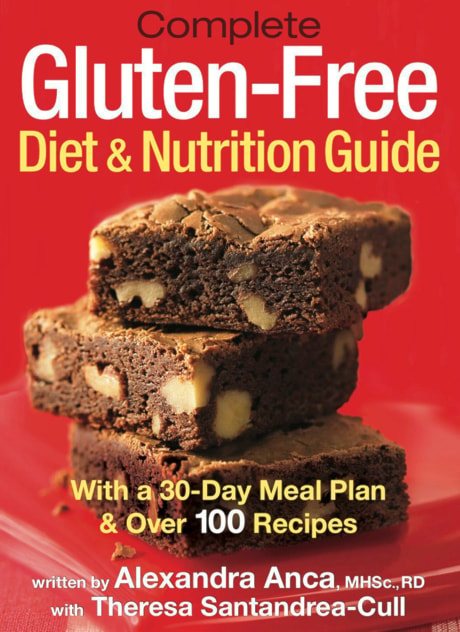TORONTO — A gluten-free diet is one of the most challenging diets to adopt and follow, but those with celiac disease who do so often suddenly feel better, says a dietitian who counsels patients with the condition.
“The gluten-free diet can be delicious, it is doable and it can be extremely nutritious,” says Alexandra Anca, author of Complete Gluten-Free Diet and Nutrition Guide (Robert Rose, 2010).
“A lot of people with celiac disease think that you have to give away taste with the gluten-free diet, that everything tastes like cardboard. That’s not true. And what’s most important, you can get all the nutrients you need by following this diet while maintaining a healthy weight.”
In patients with celiac disease, the lining of the intestine is damaged and cannot absorb calories, fibre, iron, calcium, vitamins, folic acid and so on that are needed for good health.
“Once you implement the gluten-free diet and the lining of the intestine heals then you do start to be able to absorb again those nutrients from foods, but it takes a while for that to happen,” anywhere from six months to a year depending on the individual and how much damage there is, Anca says.
The book expands on a pocket guide for which Anca was the lead researcher that lists foods and ingredients that are allowed, not allowed or are questionable in the gluten-free diet.
In her counselling she found that celiac patients wanted meal plans, tips, nutritional advice and recipes, and these are provided in the new book.
“I have so much respect for these people. It takes so much knowledge to comprehend that certain ingredients may contain trace amounts of gluten and there are so many.
“You pick up a product and there could be ingredients that you can’t even pronounce let alone know whether they’re safe for you or not.
And to balance that with the need for proper nutrition is very difficult for someone who doesn’t have a science background or a nutrition background.”
People with celiac disease want to be able to dine away from home and the book offers survival tips.
“Travelling, eating out and sharing meals with family and friends can be very emotionally charged and sometimes stressful for those with celiac disease.
“One has to become quite assertive about their needs when they are diagnosed with a disease,” Anca says. “They need to ensure that they aren’t going to ingest something that is going to hurt them.”
She advises contacting a restaurant ahead of time to find out whether a gluten-free diet can be accommodated and if the kitchen staff is well educated about avoiding sources of cross-contamination.
“With family and friends it’s even more emotionally charged because you have friends who have gone out of their way to make something that’s gluten-free for you and yet you still have to be inquisitive about what the ingredients were, whether that family member had considered sources of cross-contamination such as did they use their own baking trays, did they use the same measuring cups that they typically use for regular flour.
All these little points need to be covered and yet you don’t want to offend anyone with your questions,” says Anca.
Metal baking trays and measuring cups, plastic measuring cups and wooden and plastic cutting boards tend to have scratches that can harbour traces of regular flour or other ingredients that have previously been used.
Line a baking tray with parchment paper to create a barrier to avoid cross-contamination or opt for glass baking trays, measuring cups and cutting boards that have been thoroughly washed.
Anca, 36, has been working since 2004 with the Toronto chapter of the Canadian Celiac Association, which is where she met her co-author.
Theresa Santandrea-Cull, who along with her two sons has a gluten sensitivity, has been cooking gluten-free for her family for about 25 years.
“When it comes to baking Theresa doesn’t choose any of the expensive ingredients such as xanthan gum or guar gum that help to replace the gluten. And yet the results are so delicious,” says Anca.
Cranberry Banana Loaf
There’s no need to wait for the frozen cranberries to thaw; just add them to the batter straight from the freezer.
If you don’t have a glass loaf dish, use a metal loaf pan and increase the baking time by 5 to 10 minutes.
125 ml (1/2 cup) white rice flour
50 ml (1/4 cup) brown rice flour
50 ml (1/4 cup) quinoa flour
10 ml (2 tsp) gluten-free baking powder
7 ml (1 1/2 tsp) ground cinnamon
1 ml (1/4 tsp) salt
125 ml (1/2 cup) granulated raw cane sugar
50 ml (1/4 cup) butter or vegan hard margarine, softened
2 eggs
250 ml (1 cup) mashed ripe bananas
250 ml (1 cup) fresh or frozen cranberries
Preheat oven to 180 C (350 F). Grease a 23-by-13-cm (9- by-5-inch) glass loaf dish and line the bottom with parchment paper.
In a medium bowl, whisk together white rice flour, brown rice flour, quinoa flour, baking powder, cinnamon and salt.
In a large bowl, using an electric mixer, cream sugar and butter until light and fluffy. Beat in eggs, one at a time, until well blended. Stir in bananas. Stir in dry ingredients until combined. Gently fold in cranberries.
Pour batter into prepared loaf dish. Bake in preheated oven for 45 to 50 minutes or until a tester inserted in the centre comes out clean.
Let cool in dish on a wire rack for 10 minutes. Remove from dish and peel off paper. Transfer loaf to rack and let cool completely.
Makes 8 slices (1 slice per serving).
Nutrition information per serving: 210 calories; 33 g carbohydrate; 2 g fibre; 3 g protein; 7 g fat; 1 mg iron; 12 mg calcium 12 mg.
Source: Complete Gluten-Free Diet & Nutrition Guide by Alexandra Anca and Theresa Santandrea-Cull (Robert Rose Inc., www.robertrose.ca, 2010.)
